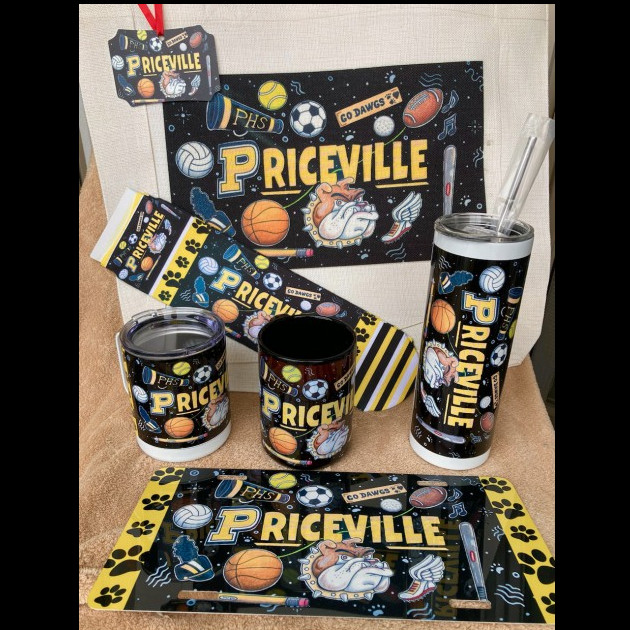How do I price my custom print-on-demand products for retail?
One of the most common questions I'm asked is “how much should I charge for a sublimated “X”? As a creative entrepreneur, naturally you want to focus on creating great looking, quality products for your customers.With so many great blank substrates available, simply choosing which products will work for your business can be a challenge itself! Once you dial in a new technique or design for a substrate you intend to sell, you'll need to determine what it's worth.
Exploring Retail Pricing Strategies for the Sublimation Industry
The key factors to consider when pricing custom print-on-demand products for retail are cost of goods sold (COGS), production time, consumables such as ink and paper, packaging, shipping, and marketing expenses. Once you have a basic formula for these factors, you can begin to put together a solid retail pricing strategy.
When setting prices for sublimation products, several strategic approaches can help align your pricing with business goals, market conditions, and customer expectations. In the sublimation industry, where products are often customized and unique, selecting the right pricing strategy is crucial for profitability and competitive edge. Here, we delve deeper into four effective pricing strategies: Cost-Plus Pricing, Value-Based Pricing, Competitive Pricing, and Keystone Pricing.
Cost-Plus Pricing:
Cost-plus pricing is a straightforward strategy where the selling price is determined by adding a predefined markup to the total production cost of a product. This approach ensures that all costs are covered and a profit margin is secured. Here's a detailed breakdown of how this might look for a sublimation product:
- Material costs: $2.53
- Labor costs: $2.53
- Shipping costs: $0.25
- Marketing and overhead costs: $0.25
- Total cost: $5.56
By applying a markup (e.g., 300%), the selling price would be calculated as follows:
Cost ($5.56) + Markup (300%) = Selling price ($16.68)
To appeal to customers, this figure might be adjusted to a retail-friendly price point, such as rounding to $15.95 or $16.95.
Implementing cost-plus pricing effectively requires an in-depth understanding of all costs involved in product production, from direct costs like materials and labor to indirect costs such as overhead and marketing. This approach ensures that the business can maintain profitability even when production costs fluctuate. Additionally, by understanding these costs and managing them efficiently, businesses can adjust their markup strategies to stay competitive while ensuring financial stability. Cost-plus pricing is particularly advantageous for businesses looking for a straightforward way to manage pricing in a dynamic market environment, allowing for consistent profit margins regardless of external pricing pressures.
Value-Based Pricing:
Value-based pricing is a strategy that relies heavily on the perceived value of a product to the customer, rather than the actual cost of production. This approach is particularly well-suited for the sublimation market, where products are often highly personalized or uniquely customized. By leveraging the distinctive characteristics of sublimation products, businesses can justify higher price points that reflect the special value these items offer to consumers.
For example, consider a sublimation business specializing in custom-printed t-shirts that feature not only unique designs but also use eco-friendly inks and high-quality, sustainable fabrics. Here’s how value-based pricing could be structured:
- Base price of similar plain t-shirt: $10
- Added value for customization (unique design): +$5
- Added value for using sustainable materials and eco-friendly inks: +$5
- Perceived emotional value (e.g., part of proceeds goes to environmental causes): +$5
- Total perceived value price: $25
In this scenario, the business sets the selling price at $25, significantly above the cost of production, by capitalizing on the t-shirt's unique aspects and the emotional appeal of contributing to a social cause. This pricing strategy can be particularly effective if the target demographic values sustainability and personal expression highly, which justifies the premium price.
Implementing value-based pricing successfully requires a thorough understanding of customer demographics, preferences, and values. It involves market research to capture insights into what customers truly value in a product and how much they are willing to pay for those added benefits. This strategy not only helps in justifying a higher price but also in establishing a brand perceived as high-value and customer-centric.
Competitive Pricing:
Competitive pricing is a strategy that sets prices based on what competitors charge for similar products. This method is particularly relevant in industries like sublimation, where products often have similar attributes and differentiation may be subtle. By pricing products slightly below the competition, businesses can capture the attention of price-sensitive customers, potentially increasing market share.
For example, imagine a sublimation business that specializes in custom coffee mugs. If the major competitors are pricing their similar custom mugs at $15, the business might decide to set their price at $14.50. Here’s how competitive pricing could be structured:
- Average competitor price for similar custom mugs: $15
- Slight price reduction to gain competitive advantage: -$0.50
- Competitive pricing offer: $14.50
This strategic pricing not only makes the mugs more appealing to bargain hunters but also positions the business as a cost-effective option without engaging in a price war that could harm profit margins.
Implementing a competitive pricing strategy effectively requires ongoing market research to monitor competitor prices and promotional strategies regularly. It also involves analyzing how price changes affect sales volumes and overall profitability. This strategy can be combined with other marketing tactics like seasonal discounts or loyalty programs to enhance customer retention and value perception, ensuring the business remains competitive while protecting its margins.
Keystone Pricing:
Keystone pricing is a straightforward and traditional retail pricing strategy where the retail price is set at double the wholesale cost. This approach is commonly used in sectors where products are standardized, and there is a clear distinction between wholesale and retail pricing levels. While less common in highly customizable industries like sublimation, it can still be applicable when products achieve a standard form and are sold in larger volumes.
For instance, if a sublimation business decides to standardize a line of coasters that are popular and consistently produced, keystone pricing could be effectively implemented. Here's how it might look:
- Wholesale cost of a standard sublimated coaster: $3
- Keystone markup (100%): +$3
- Retail price using keystone pricing: $6
This pricing model simplifies the calculation of selling prices and ensures a healthy profit margin is maintained, which can be particularly useful for businesses managing a wide range of products. Keystone pricing ensures consistency and simplicity in pricing, which can be beneficial for both the retailer and the customer by providing clear expectations.
To implement keystone pricing effectively, it is crucial to ensure that the wholesale costs are controlled and that the products offered can sustain a 100% markup without exceeding what the target market is willing to pay. This might involve bulk purchasing, cost-effective manufacturing practices, or choosing cost-efficient materials. While keystone pricing is straightforward, it should be evaluated against market tolerance and competitor pricing to ensure it does not price the products out of competitive range.
Choosing the Right Strategy
Selecting the right pricing strategy—or a combination of strategies—depends on your specific market segment, production costs, customer base, and competitive landscape. Each strategy has its strengths and is suited to different business models and product types within the sublimation industry. By aligning your pricing strategy with your overall business strategy, you can maximize profitability while meeting the needs and expectations of your customers.


































